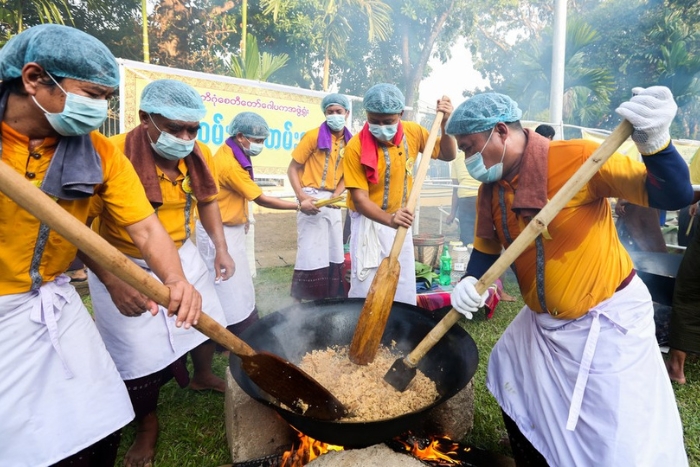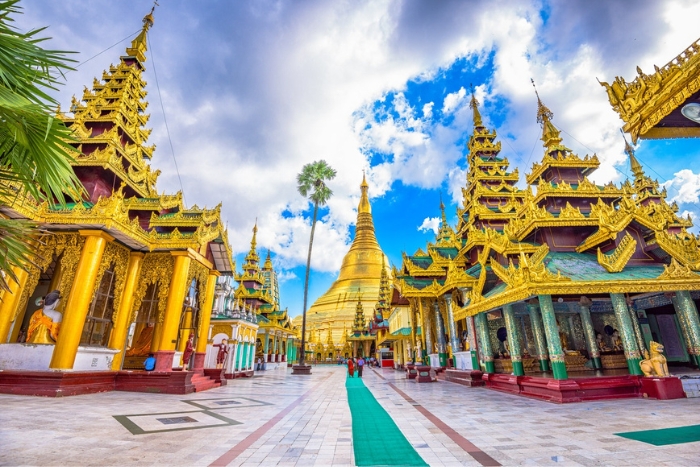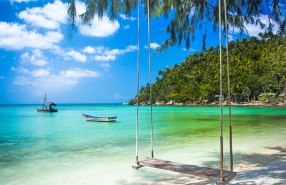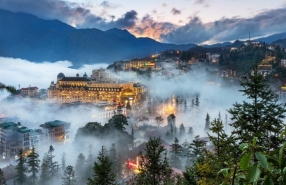Myanmar In February: Weather, Where To Go, What To See, Itinerary And FAQ

Myanmar, a treasure of Southeast Asia, attracts many tourists, especially in February. This month offers ideal weather for travel, with pleasant temperatures and a dry climate, perfect for discovering its enchanting landscapes and experiencing unforgettable cultural moments. Whether you are drawn to its majestic temples or vibrant festivals, this guide will provide you with all the keys to maximize your experience in Myanmar. Explore Myanmar in February with Autour Asia, Myanmar Travel Agency.
Table of Contents
I. Overview of the Weather in Myanmar in February
Myanmar in February is one of the best times to explore this beautiful country, particularly during the first half of the month, before temperatures begin to rise. Visiting Myanmar in February is ideal because the weather is pleasant, warm, and dry, offering ideal conditions in almost all regions of the country. The weather in Myanmar in February is often characterized by many sunny days, long hours of daylight, and clear skies; and very little precipitation, if any, making the stay very comfortable.
Average temperatures range between 28°C and 38°C, making the atmosphere pleasant and perfect for discovering the various regions of the country. Regarding the weather in Myanmar in February in the western regions and the highlands of the east and north, although the cold has eased, mornings and evenings can still be a bit cool. If you plan to visit these areas, we recommend bringing a coat or jacket. The weather in Myanmar in February offers a maximum temperature of 33°C in the plain regions, while the highlands of the east and north reach 20°C, making them comfortable for travelers.

The south and west coasts of Myanmar in February benefit from sunny and warm weather, making them ideal destinations for beach holiday enthusiasts. The beaches are sun-kissed, providing a perfect setting for those seeking moments of relaxation under the tropics.
The central plains, on the other hand, begin to warm up and remain mostly dry, especially in the following months. What to do in Myanmar in February? This is the perfect time to explore the iconic temples and pagodas of Bagan and Mandalay, which are unforgettable experiences to have during a trip to Myanmar in February.
It is important to note that visiting Myanmar in February, although it is one of the best times of the year, also means facing an influx of tourists. Hotels are more expensive, guided tours are often full, and tourist sites can be a bit crowded. That’s why we advise you to book in advance to fully enjoy the weather in Myanmar in February and the best travel experiences that the country has to offer.
II. What to See in Myanmar in February? TOP Festivals and Events in Myanmar in February
Myanmar in February offers a variety of vibrant festivals and events. These celebrations allow travelers to experience unique cultural moments.
1. Union Day
Union Day (February 12 each year) commemorates the Panglong Agreement signed on February 12, 1947, by General Aung San and over 20 ethnic leaders to regain independence from British colonialists. This agreement unified several ethnic groups.

The festivities include parades, traditional dances, and sporting events. Across Myanmar in February, locals gather in public squares to participate in or witness these activities, reinforcing national pride and unity.
2. Mahamuni Pagoda Festival
What to see in Myanmar in February? Celebrated over two days, on the 14th and 15th of the full moon of Thabodwe, the Mahamuni Pagoda Festival takes place at the prestigious Mahamuni Pagoda in Mandalay.
According to legend, the statue of the Mahamuni Buddha was created just in front of the Buddha, making it a highly revered religious site among locals. This statue is covered with a layer of gold reaching 15 centimeters thick. The Mahamuni Pagoda is one of the most famous in Myanmar.
During the festival, monks recite sutras for several days, and people gather around the Mahamuni Pagoda to pay homage to the image of the Mahamuni Buddha. Thousands of devotees come to make offerings and participate in rituals, burning various sticks of incense as offerings.

As part of the festival, devotees prepare sticky rice over bonfires and offer it to the monks present in the area. This sticky rice is prepared with ginger, coconut, and sesame.
The pagoda grounds come alive as thousands of locals and tourists flock to the site. Travelers can join in the celebrations, experience the festive atmosphere, and capture memorable moments from this unique festival in Myanmar in February.
Traditional dances, musical performances, and market stalls selling local products enrich the festive atmosphere. This event embodies the rich religious traditions and dynamic community life of Myanmar. Visiting the Mahamuni Pagoda during this time allows tourists to discover the cultural and spiritual activities of Myanmar in February and capture unforgettable moments.
3. Shwe Mann Settaw Pagoda Festival
The Shwe Mann Settaw Pagoda Festival, celebrated for 11 days starting from the 5th day of Waxing of Tabodwe, is one of the most revered events in the Magwe region, in central Myanmar, especially among the residents of Upper Myanmar. The region comes alive from mid-February to mid-April, as hundreds of locals and tourists gather to participate in this vibrant festival.
Visitors have the chance to discover the golden sacred footprints of the Buddha, believed to have been left by the Buddha himself, preserved in two pagodas along the Mann River. Pilgrims engage in merit-making activities, worship the Buddha, and pray under the guidance of monks, creating a deeply spiritual atmosphere. The monks lead prayers for the thousands of participants making the pilgrimage, dressed in colorful traditional costumes.
Along the way, many stalls sell a variety of products, ranging from handicrafts to traditional medicinal plants. As you continue your walk, you will reach Mutsoetaung Zedi, where you can enjoy a lush landscape.

At the lower pagoda of Sattawyar, located at the foot of the hill, numerous bamboo huts line the riverbank, providing a refreshing break for visitors wishing to relax and swim during the hot and dry season of Myanmar in February.
Locals have built bamboo shelters to allow travelers to rest and recharge after a long journey. The lively festival stalls, overflowing with products from all over the country, offer a range of items for pilgrims to explore.
After an exhausting pilgrimage, bathing in the cool, clean, and sparkling waters of Mann Creek provides a rejuvenating experience. All these elements combine to make the journey to the Shwe Mann Sattaw Pagoda a truly unforgettable experience. This is definitely what to do in Myanmar in February for those seeking an authentic experience.
4. Kyaik Khauk Pagoda Festival
What to do in Myanmar in February? Discover the Kyaik Khauk Pagoda Festival, celebrated for eight days, from the 8th day of Waxing to the full moon of Tabodwe. This festival takes place every February at the Kyaik Khauk Pagoda in Thanlyin, Yangon. It is one of the most renowned temple celebrations in Myanmar in February, regarded as the harvest festival in Yangon.
This festival includes a huge fair organized by the locals to celebrate the event. Vendors sell numerous traditional items that can only be found in Myanmar, such as handicrafts, silk products, clothing, lacquerware, dishes, and more.
Merchants arrive with large carts loaded with goods to sell at the festival, creating a unique traditional atmosphere around the event. Tourists can browse the stalls and purchase these items as souvenirs.

It is one of the most famous temple festivals in Myanmar in February. Most activities take place in the evening, featuring nighttime performances and outdoor films. During the festival, traditional dance and folk song performances are also presented.
Locals typically travel to the pagoda by ox cart, adding an authentic flavor to the experience. Don’t miss the opportunity to immerse yourself in this celebration during a day trip from Yangon. It is undoubtedly what to see in Myanmar in February to discover local culture and have an unforgettable moment.
5. Moe Byae Festival
The Moe Byae Festival lasts four days, from the end of January to February 3, and takes place in a small town in Shan State, at the border of Shan and Kayah States.
As the largest festival in Shan State, it attracts visitors from across the country eager to witness its ornate decorations and the lively market surrounding the central pagoda. Thousands of participants, mainly from hill tribes such as the Pao, Kayah, Shan, and even a few Padaung from nearby villages, gather to partake in religious rituals and enjoy traditional songs and dances.
With a diversity of ethnicities present, the festival offers an abundance of delicious dishes, accompanied by captivating performances and shows, creating a vibrant and unforgettable atmosphere.
If you are wondering, “What to do in Myanmar in February?” the Moe Byae Festival is a must-experience to delve into the cultural and spiritual traditions of the country.
6. Htamane Sticky Rice Cooking Festival
What to do in Myanmar in February? The Htamane Sticky Rice Cooking Festival - an experience that will allow you to discover local culture and traditions in a warm and festive atmosphere.
Also known as the Sticky Rice Festival, Htamane is celebrated throughout Myanmar in February, for one day, coinciding with the Full Moon of Tabodwe.
During this vibrant festival in Myanmar in February, people come together to cook sticky rice, participating in a competition to prepare the best sticky rice. At dawn on the Full Moon, the delicious rice is offered to the Great Lord Buddha as a sign of gratitude.

After the offering, the sticky rice is distributed to all participants. An award ceremony recognizes the winners of the cooking competition, adding excitement to the celebration.
Tourists are invited to enjoy lively performances and cooking competitions. After the offering, everyone can sit together to taste the sticky rice while sharing stories and discovering the different cultures.
The preparation of Htamane begins with soaking the sticky rice overnight. The next day, small pieces of coconut are fried and mixed with other ingredients. The soaked rice is then added to the pan, where two strong men stir it until perfectly cooked. Finally, the Htamane is offered to the Buddha and generously shared with all the pagoda visitors.
III. What to do in Myanmar in February?
1. Discovering Yangon
There are many things to do in Yangon, Myanmar: visit beautiful temples, stupas, and monuments, and explore colorful stalls. In particular, the climate in Myanmar in February is very pleasant for discovering the temples of Yangon. Here’s our selection of must-see sites and temples to visit in Yangon:
- Shwedagon Pagoda – The Largest Golden Structure: No trip to Myanmar is complete without visiting Shwedagon Pagoda, built over 2,500 years ago during the time of Gautama Buddha. This golden monument is the Golden Glory and the soul of the Burmese people. Its elegant architecture fascinates, especially at sunset, when the golden hues illuminate. This is the best time to visit Shwedagon Pagoda.

- Sule Pagoda – The Heart of Yangon: Of Mon style and octagonal shape, Sule Pagoda shines with a bright gold. Standing 144 feet tall, it was built 2,200 years ago in the center of Yangon. Known as "Kyaik Athok" in Mon, it means "Pagoda of the Sacred Hair Relic" and stands like a golden beacon amidst the urban hustle and bustle.

Botahtaung Pagoda: Dating back over 2,500 years, this pagoda houses a sacred hair of Buddha. Although destroyed during World War II, it has been rebuilt, and remnants of the original structure are still visible inside. Its name, meaning "thousand chiefs," honors the military leaders who escorted the relics of Buddha from India over 2,000 years ago. Notably, its hollow interior allows visitors to walk inside.
Among other famous pagodas in Yangon that you can visit are Chauk Htat Gyi Pagoda, Bago Pagoda, Nga Htat Gyi Pagoda, Koe Htat Gyi Pagoda, and Kaba Aye Pagoda – the "Pagoda of World Peace."
Bogyoke Aung San Market (formerly Scott Market): Bogyoke Aung San Market, formerly known as Scott Market, is renowned for its colonial architecture and its cobbled interior pathways. It’s the perfect place to find the largest range of Burmese souvenirs. Whether you’re a shopping enthusiast or simply looking for a unique keepsake, Bogyoke Market is a fabulous destination to stock up on finds!
Kandawgyi Lake or Royal Lake, is one of the most picturesque attractions in Yangon, especially at sunset. Located on Kandawgyi Kanpat Road, near the famous Shwedagon Pagoda, it offers a relaxing space after a day of exploration in Myanmar in February. Spanning 61 hectares, the lake is surrounded by Kandawgyi Nature Park, Yangon Zoo, an oceanographic institute, and an amusement park. This complex is ideal for adults seeking relaxation and children looking for entertainment. Visitors can admire the beauty of the lake from different angles, as the landscape changes from day to night. In the middle of the lake stands the Karaweik Palace on a barge, decorated with a mythical bird, a symbol of Burmese architecture, enhancing the beauty of the surrounding gardens. In addition to rejuvenating the soul, this place is an attractive spot for both foreigners and local tourists. From there, you can admire the Shwedagon Pagoda. Imagine, on a beautiful evening, watching the stunning sunset behind this iconic pagoda. It’s an unforgettable experience not to be missed during your stay in Myanmar in February!

2. The Sacred Plain of Bagan: Ideal for a Hot Air Balloon Flight
What to do in Myanmar in February? Don’t miss this unique opportunity to discover the wonders of Baganfrom the skies and appreciate the beauty of one of Myanmar's most iconic destinations in February.
A trip to Myanmar in February is the perfect opportunity to explore Bagan and its ancient temples. The weather in Myanmar in February remains pleasant, ideal for discovering the historical ruins or enjoying an unforgettable hot air balloon experience at sunrise or sunset.

The Sacred Plain of Bagan is filled with magnificent temples and ruins, often surrounded by lush hills and enchanting landscapes. It’s one of the best places to experience the memorable adventure of a hot air balloon flight. The balloons provide an exotic and impressive way to admire this spectacular landscape, where 2,500 temples rise above lush vegetation and palm tree forests. In Myanmar in February, hot air balloons are often fully booked, so it’s essential to reserve your tickets in advance to enjoy this incredible adventure.
3. Pindaya Cave in Myanmar: An Unmissable Spiritual Sanctuary
Pindaya Cave in Myanmar, located in Shan State, is an important spiritual site for many Buddhist devotees in the land of pagodas. Situated about 100 km from Inle Lake, this limestone cave is found on the hillside at an altitude of 1,200 meters. This iconic place inspires those wishing to discover the history, ancient culture, and seek a sacred Buddhist sanctuary.
Myanmar in February, is considered one of the best times to admire the enchanting landscapes of Pindaya cave. The sky is clear, and rainfall is rare. As this is a peak season, many visitors flock to participate in leisure and exploration activities. Pindaya Cave then welcomes a large number of pilgrims and tourists.

The journey to reach Pindaya Cave can be challenging, but it is full of attractions, especially for those who love adventure. Although climbing the hundreds of steps can be exhausting, the reward is breathtaking views of the surrounding nature.
When visiting Pindaya Cave, you can admire a multitude of Buddha statues of all sizes, all adorned with gold leaves, with about 8,000 statues spread over 150 meters in the cave. Pindaya Cave captivates visitors with its beautiful stalactites, formed by water droplets depositing over millennia. The stalactite formations, of all sizes and colors, create a fascinating spectacle.
While exploring Pindaya Cave, you will also have the opportunity to discover a lively local market, rich in handicrafts, or learn about the cigar-making process.
What to do in Myanmar in February? Don’t miss the chance to visit Pindaya Cave, a spiritual and cultural gem that should not be missed during your trip to Myanmar in February.
Myanmar in February is an unmissable destination for a memorable trip. The weather in Myanmar in February is ideal, with a mild climate that invites exploration. So, what to do in Myanmar in February? Immerse yourself in its vibrant festivals, admire its breathtaking landscapes, and dive into its fascinating cultural heritage. Let yourself be enchanted by the magic of Myanmar and the warm welcome of its people. To organize your trip and experience unforgettable moments, contact us at AUTOUR ASIA, Myanmar Travel Agency.
The following circuits should be considered:
>> Myanmar Day Trips
>> Hot air balloon ride in Bagan, Myanmar
>> Tour package in Myanmar
>> Myanmar 9 days
The electronic tourist visa for Myanmar is an official document allowing entry into Myanmar, issued electronically by the government of the Republic of the Union of Myanmar. Visa applicants must fill out an online form and upload the necessary documents. Once the visa is approved, they will receive it by email. If you want to travel to Myanmar, click our Myanmar Packages Tours!
To enter Myanmar, you must have a valid passport with at least six months' validity remaining and a valid visa. You must apply for your visa at a Myanmar embassy or consulate abroad before arriving in Myanmar. For stays of more than 28 days or multiple entries, consult the nearest Myanmar embassy. Check out our useful information about Myanmar for your complete trip!
When visiting a temple in particular or other religious sites in Myanmar, it is important to wear conservative clothing that covers the shoulders, arms, and knees, in accordance with traditional modesty. Since the festival takes place on a sacred site, it is common to see locals and tourists dress respectfully. Additionally, it is necessary to remove shoes before entering a sacred building, which shows appreciation for the locals' customs and traditions. For more information about traveling to Myanmar, contact us at AUTOUR ASIA, Travel and Tour in Myanmar.
Related travel guide
Other similar articles
CUSTOMIZABLE BY LOCAL EXPERTS
Personalized trip at the original price!
REFUND GUARANTEE
We believe in our work and promise to give you money back.
GOOD PRICE / QUALITY
95% satisfied more than expected!
24/7 LOCAL SUPPORT
We are always available online to provide assistance at any time.
Most read articles
Autour Asia is highly recommended on
Embracing the mission of "Satisfied more than expected" and providing authentic experiences, we have received numerous recommendations on reputable travel forums:























